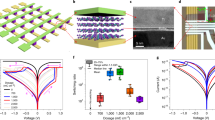Abstract
Memristor crossbars are capable of implementing learning algorithms in a much more energy and area efficient manner compared to traditional systems. However, the programmable nature of memristor crossbars must first be explored on a smaller scale to see which memristor device structures are most suitable for applications in reconfigurable computing. In this paper, we demonstrate the programmability of memristor devices with filamentary switching based on LiNbO3, a new resistive switching oxide. We show that a range of resistance values can be set within these memristor devices using a pulse train for programming. We also show that a neuromorphic crossbar containing eight memristors was capable of correctly implementing an OR function. This work demonstrates that lithium niobate memristors are strong candidates for use in neuromorphic computing.







Similar content being viewed by others
References
Snider GS (2008) Cortical computing with memristive nanodevices, SciDAC review
Jo SH, Kim K-H, Lu W (2009) High-density crossbar arrays based on a–Si memristive system. Nano Lett 9(2):870–874
Yakopcic C, Hasan R, Taha TM (2015) Memristor based neuromorphic circuit for ex-situ training of multi-layer neural network algorithms, IEEE IJCNN, 2015
Taha TM, Hasan R, Yakopcic C (2014) Memristor crossbar based multicore neuromorphic processors, IEEE International SOCC, 2014
Yakopcic C, Taha TM (2015) Determining optimal switching speed for memristors in a neuromorphic system. Electron Lett 51(21):1637–1639
Alibart F, Zamanidoost E, Strukov DB (2013) Pattern classification by memristive crossbar circuits with ex-situ and in-situ training, Nat Comm, vol 4, June 2013
Yakopcic C, Taha TM, Hasan R (2014) Hybrid crossbar architecture for a memristor based memory, IEEE National Aerospace and Electronics Conference (NAECON), pp 237–242, 2014
Yakopcic C, Hasan R, Taha TM (2015) Hybrid crossbar architecture for a memristor based cache. Microelectron J 46(11):1020–1032
Wang S, Wang W, Yakopcic C, Shin E, Subramanyam G, Taha TM (2015) Lithium based memristive device, IEEE National Aerospace and Electronics Conference, 2015
Li H, Xia Y, Xu B, Guo H, Yin J, Liu Z (2010) Memristive behaviors of LiNbO3 ferroelectric diodes. Appl Phys Lett 97:012902
Pan X, Shuai Y, Wu C, Luo W, Sun X, Zeng H, Zhou S, Bottger R, Ou X, Mikolajick T, Zhang W, Schmidt H (2016) Rectifying filamentary resistive switching in ion-exfoliated LiNbO3 thin films. Appl Phys Lett 108:032904
Liu X, Biju KP, Lee J, Park J, Kim S, Park S, Shin J, Sadaf SMd, Hwang H (2011) Parallel memristive filaments model applicable to bipolar and filamentary resistive switching. Appl Phys Lett 99:113518
Kozicki MN, Balakrishnan M, Gopalan C, Ratnakumar C, Mitkova M (2005) Programmable metallization cell memory based on Ag–Ge–S and Cu–Ge–S solid electrolytes, In: Proceedings of Non-Volatile Memory Technology Symposium, pp 83–89
Lu W, Kim K-H, Chang T, Gaba S (2011) Two-terminal resistive switches (memristors) for memory and logic applications, In: Proceedings of the 16th Asia and South Pacific Design Automation Conference, pp 217–223
Miao F, Strachan JP, Yang JJ, Zhang M-X, Goldfarb I, Torrezan AC, Eschbach P, Kelley RD, Medeiros-Ribeiro G, Williams RS (2011) Anatomy of a nanoscale conduction channel reveals the mechanism of a high-performance memristor. Adv Mater 23(47):5633–5640
Brivio S, Covi E, Serb A, Prodromakis T, Fanciulli M, Spiga S (2016) Experimental study of gradual/abrupt dynamics of HfO2-based memristive devices. Appl Phys Lett 109:133504. doi:10.1063/1.4963675
Zhang JJ, Sun HJ, Li Y, Wang Q, Xu XH, Miao XS (2016) AgInSbTe memristor with gradual resistance tuning. Appl Phys Lett 102:183513. doi:10.1063/1.4804983
Yakopcic C, Taha TM, Subramanyam G, Pino RE (2015) Impact of memristor switching noise in a neuromorphic crossbar IEEE National Aerospace and Electronics Conference, June 2015
Yakopcic C, Taha TM, Subramanyam G, Pino RE (2013) Generalized memristive device SPICE model and its application in circuit design. IEEE Trans Comput Aided Des Integr Circuits Syst 32(8):1201–1214
Yakopcic C, Taha TM, Subramanyam G, Pino RE (2013) Memristor SPICE model and crossbar simulation with nanosecond switching time, IEEE International Joint Conference on Neural Networks (IJCNN), August 2013
Author information
Authors and Affiliations
Corresponding author
Ethics declarations
Conflict of interest
The authors declare that they have no conflict of interest.
Rights and permissions
About this article
Cite this article
Yakopcic, C., Wang, S., Wang, W. et al. Filament formation in lithium niobate memristors supports neuromorphic programming capability. Neural Comput & Applic 30, 3773–3779 (2018). https://doi.org/10.1007/s00521-017-2958-z
Received:
Accepted:
Published:
Issue Date:
DOI: https://doi.org/10.1007/s00521-017-2958-z




